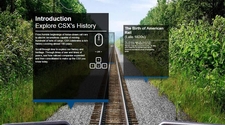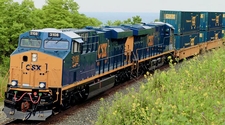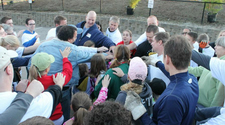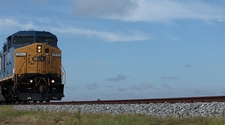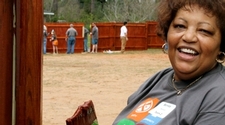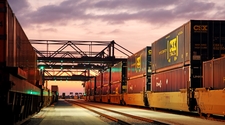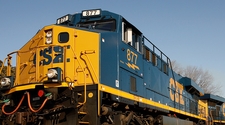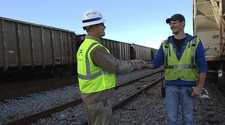| B End of Car
|
The end on which the hand brake is located. |
| B Unit |
A cabless locomotive slug unit, not equipped with a diesel engine, but equipped with MU capability and traction motors, which receive electrical power from an "A" unit or mother locomotive. |
| Back Contact |
A part of a relay against which, when the relay is de-energized, the current carrying portion of the moveable neutral member rests so as to form a continuous path for current. |
| Back-Haul |
To transport a shipment back over part of a route which it has traveled. |
| Back-Haul Corridor |
A route or part of a route over which a car has previously traveled. To reduce the amount of cars returning empty, discount rates are sometimes offered to attract traffic to the back-haul corridor. |
| Back-Hose (Slang) |
A portable back-up valve. |
| Back-Up |
A copy of a file or database, to be used if reconstruction is necessary. |
| Back-Up Hose |
A portable hose and valve assembly provided for the purpose of applying brakes from the leading end of a car when it is necessary to push or back trains or cars. The device is connected to the brake pipe hose. |
| Back-Up Valve |
A valve on caboose platforms and some types of passenger cars that is connected to the brake pipe. It may be used to apply brakes during pushing or back-up movements. |
| Bad Order Cars |
When a car inspector finds a defective car, he tacks a small card labeled "bad order" in bold lettering on or near the door of the car. That car may not be moved from the terminal where the inspection occurred until the necessary repairs are made. |
| Balance Due Bill |
Bill rendered by railroad for undercharges. |
| Balance Out |
Additional amount due after paid-in is deducted from through rate. |
| Balance Speed |
The speed at which the tractive effort exerted by the locomotive is equal to the train resistance, resulting in a constant speed. A change in either tractive effort or train resistance will cause a corresponding change in speed until a new balance speed is reached. |
| Ballast |
Selected material placed on the roadbed for the purpose of holding the track in line. |
| Ballast Resistance |
The resistance offered by the ballast, ties, etc., to the flow of leakage current from one rail of the track circuit to the other. |
| Ballast Tamper |
A machine for compacting ballast under the ties. |
| Balloon Track |
An arrangement of tracks in the form of a balloon used for turning around engines, cars, and trains. |
| Bank Charge Back |
A document which tells a Revenue Management Collector why the customer disagrees with the original freight bill. When a customer audits a bill paid through a lock box, he tells his bank to debit CSXT's account for the difference between what was paid on a freight bill and what he feels should have been paid or for the full amount of the bill. When the bank debits CSXT's account, they will complete a bank charge-back slip. |
| Bank Number |
An identifying number assigned to each of the Lock Box Banks. |
| Basing Point |
A geographic point where the rates to and from are used to construct a through rate to other points. |
| Batch |
An accumulation of data to be processed, or a computer process that is transparent to the user. |
| Battery |
A combination of two or more galvanic cells electrically connected to work together to produce electrical energy. Common usage permits this designation to be applied also to a single cell used independently. |
| Belt Line or Terminal Railroad |
A short line railroad operation within and/or around a city and connecting with one or more larger or trunk line railroads. |
| Beneficial Owner (AKA Bene Owner) |
The customer who actually owns the lading. |
| Bi [Slang]
|
Slang for Bi-Level Car.
|
| Bi-Level Car |
A two-level freight car used for transporting automobiles and other vehicles. |
| BIDS (Bulk Intermodal Distribution Services) |
The CSX bulk commodity storage and distribution service. |
| Big Hole (AKA Soak-Em, Shoot-Em) |
Emergency application of the air brake valve. The act of abruptly applying the brakes to the fullest possible reduction. |
| Big Hook |
Wrecking crane. |
| Bill of Lading |
A shipping document that is both a receipt for property to be transported and a contract for hauling it, stating the terms, conditions, and liabilities under which property is accepted for transportation. The principal Bill of Lading types are: Clean: A bill of lading without notation of damage or shortage of property. Domestic: Covers shipments within the U.S.A. Export: Covers shipment to a foreign country. Government: A special shipping document which is used in making shipment for the U. S. Government. |
| Bill of Lading Act |
An act of Congress relating to the preparation and negotiability of the bill of lading. |
| Billed At Station |
The station which prepares the waybill. |
| Billed Weight |
The weight shown on a bill of lading or freight bill. |
| Billet Car |
A low side gondola, built of steel throughout, used to transport hot steel billets or other heavy materials. |
| Billing Address |
Patron address for freight billing. |
| Billing Repair Card |
The card furnished to the car owner when repair is done on a foreign car. |
| Billing Road |
Railroad which originates shipment and issues the waybill. |
| Billing Road Code |
An accounting number assigned to the railroad by the AAR. |
| Binding Post |
A device to which electrical conductors may be terminated conveniently. |
| Blanket Bond |
A bond covering a group of persons or property. |
| Blanket Rate (AKA Group Rates) |
A rate published to apply from or to a large number of points grouped into a defined origin or destination cluster. |
| Blanket Supplement |
A single publication containing additions or changes to a number of tariffs. |
| Blanket Waybill |
One waybill produced for a multiple car shipment. The waybill is associated with the lead car, while the other cars are listed in the body of the waybill for the lead car. |
| Bleed a Car |
To drain the air from a car's reservoir by pulling a rod on the side of the car. Bleeding removes air brakes, but not the hand-brakes, allowing the car to roll freely. |
| Blind Siding |
A rail siding used for the placement or storing of cars at a point where no agent or rail representative is assigned. Cars placed and pulled at these locations are reported by conductors to the agent having jurisdiction over the blind siding. |
| Block |
A track section of defined limits. In signaled territory, a block is the track section between two consecutive block signals governing movements in the same direction. It is also the track section from a block signal to the end of signaled territory. |
| Block of Cars |
A group of cars routed for a common destination which is not necessarily the final destination. |
| Block Operator |
A person who follows train dispatcher's instructions for aligning signals and switches on tracks within a block. |
| Block Signal |
An absolute or intermediate signal at the entrance to a block that governs the movement of trains using that block. |
| Block Signal System |
A method of governing the movement of trains into or within one or more blocks which use signals. |
| Block Station |
A place provided for the blocking of a train by block signals or other means. |
| Blocking and Bracing (Procedures) |
Wood or metal supports to keep shipments in place in or on cars, trailers, etc., as safety precautions for loading rail shipments which must be in accordance with the regulations of the STB, FRA, and the AAR. |
| Blocking Device |
A lever, plug, ring or other method of control that restricts the operation of a switch or signal. |
| Blocking of a Train |
The assembling of groups of "blocked" cars in proper sequence. |
| Blocking of Cars |
The assembling of cars in proper groups. |
| Blue Flag |
A metal sign placed on a track or equipment which signifies that employees are working on, under, or between equipment on that track. |
| Blue Room |
Controls the Power (Engine Utilization) in Philadelphia, PA. |
| Blue Signal
|
A clearly distinguishable blue flag (by day) or blue light (by night) that, when displayed, indicates that workers are on, under or between equipment. |
| Board |
A fixed signal regulating railroad traffic usually referred to as a slow board, order board, clear board (for clear train order signal) or red board (stop). OR A list of employees available for service. Also called extra board. |
| Boarding Car |
See Camp Car. |
| Bogey or Bogie [AKA Chassis]
|
The chassis type platform with wheels used for transporting containers over the highway.
|
| Bolster |
A cross-member on the underside of a car body and in the center of a truck, through which the weight is transmitted. The bolsters carry the body and truck center plates, the body bolster resting on the truck bolster, and is connected to it with a center pin. |
| Bolt Lock Switch
|
A hand-operated switch equipped with a pipe-connected locking device that is designated to shunt the signal system before the switch points are operated. |
| Bond of Indemnity |
An agreement relieving the carrier from liability for action for which it might otherwise be liable. |
| Bond Wire |
An electrical conductor for bridging rail joints. |
| Bonded Block |
Method of stacking the same size shipping containers in blocks so that the shipping containers in each block are bonded together both lengthwise and crosswise in the car. |
| Bonded Warehouse |
A warehouse under bond to the Government for payment of customs duties and taxes on goods stored or processed there. |
| Book or Rules |
Set of rules, which govern the standard procedure by which emplyees are required to perform their assisnged duties. |
| Booking |
An agreement under which a steamship line agrees to accept freight for transportation. |
| Boomer (Slang) |
A railroad employee who travels from road to road and stays but a very short time at any one place. |
| Bootleg |
A protection for track wires where the wires leave the conduit or ground near the rail. |
| Bowl |
A system of classification tracks resembling a bowl connected to the hump. The system is operated electronically and ensures that the cars are properly classified as they enter the hump. |
| Box Car |
An enclosed car which has doors. It is used for general service and especially for lading which must be protected from the weather. |
| Brake Application |
A reduction of brake pipe pressure of sufficient amount to cause the control or distributing valve to move to "service" or "emergency" position. A service brake application may consist of one or more reductions. |
| Brake Club |
Three foot hickory stick used by freight trainmen to tighten hand brakes. |
| Brake Cylinder |
A cylinder containing a piston and piston rod. When compressed air is admitted into the cylinder, it forces the piston outward, which applies the brake. When the compressed air is exhausted, a release spring coiled around the piston rod inside the cylinder returns the piston to its normal position, which releases the brake. |
| Brake Cylinder Relay Valve |
A remotely-controlled valve on locomotive brake cylinders in proportion to the pressure developed by the independent brake valve and control valve. |
| Brake Footboard |
See Brake Step. |
| Brake Force |
A term used to describe the ability of a train to stop. It is usually based on tons per brake ratio, with the effect of increasing braking power when the tons per brake ration is reduced. |
| Brake Pawl |
A small, specially shaped, steel piece, pivoted to engage the teeth of a brake ratchet wheel to prevent turning backward, and thus releasing the brakes. |
| Brake Pipe |
The brake pipe connects the automatic brake valve on the locomotive with the brake apparatus on all the cars in the train. It includes the branch pipe, angle cocks, cut-out cocks, centrifugal dirt collectors, strainers, hose and hose couplings used to distribute compressed air through the train. |
| Brake Pipe Cut-out Cock |
A device used to cut out the control valve on a locomotive or car. See Cut-out Cock. |
| Brake Ratchet |
A wheel attached to the brake shaft, having teeth which the pawl engages, thus preventing the wheel and shaft from turning backward. |
| Brake Releases |
There are two types of brake releases: Direct Release: This type of release is on all freight cars. When sufficient brake pipe pressure is restored to cause the control valve to move to "release" position, the brake cylinder pressure will reduce to zero. Graduated Release: This type of release is available on most passenger cars. When the brake pipe pressure is restored in small increments (graduations), this will cause the control valve to reduce brake cylinder pressure in small increments rather than di |
| Brake Shaft |
A shaft on which a chain is wound and by which the power of a hand brake is applied to the wheels. |
| Brake Shoe |
Friction material shaped to fit the tread of the wheel when the brakes are applied. |
| Brake Slug |
A locomotive, without diesel engine or traction motors, used as additional braking (in conjunction with another locomotive) for hump or yard operations. |
| Brake Step |
A small shelf or ledge on the end of a freight car on which the brakeman stands when applying the hand brake. |
| Brake Valve Cut-out Valve |
A device used for cutting in and cutting out the automatic brake valve on a locomotive. |
| Brake Wheel |
An iron wheel attached to the upper end of the brake shaft which is manually turned to apply hand brakes. |
| Brakeman (AKA Trainman) |
A train service employee responsible for the safe and efficient switching of railcars and assisting with train operations. |
| Branch Line |
A rail line which serves one or more stations beyond the junction of the main line or another branch line. A feeder line which brings freight to main lines. |
| Break Bulk |
To unload and distribute all or a portion of a load. |
| Break Bulk Point |
The location at which a portion or all of a load is removed and distributed. |
| Bridge Traffic |
Traffic received from and delivered to connecting carriers. |
| Broad Gage |
When the distance between the heads of the rails is greater than 4 feet 9 inches. |
| Brownie |
A demerit for violation of rules (See Book of Rules). |
| Bucket Yard |
A yard that does not have a Yardmaster, but is used to switch/classify or store cars. |
| Buff Forces |
During braking, the force that causes cars to bunch together. |
| Bulk Freight |
Freight that is shipped loose rather than in packages. |
| Bulk Transfer
|
The transfer of bulk products, such as plastic pellets or liquid sweeteners, from one mode of transportation to another. Bulk transfer permits off-rail shippers and receivers of varied commodities to combine rail's long-haul efficiencies with truck's convenient door-to-door delivery.
|
| Bulkhead |
A movable partition permanently installed that is used to secure the lading. See Compartmentalized Car. |
| Bulkhead Flat |
A flat car with adjustable bulkheads at each end of the car. The car is used for transporting plywood, wall board, etc. |
| Bull |
A special agent, patrolman or railroad policeman. |
| Bulletin Order |
An order which contains items affecting the movement of trains and is issued by authority and over the signature of the superintendent. |
| Bump |
The act of taking one's position and forcing the incumbent employee to another position, based on seniority. OR To move physically out of position. |
| Bumping Post or Bumper (AKA Butting Block) |
A braced post, block, or obstruction placed at the end of stub or spur track that halts car movement and prevents cars from going off the rails. |
| Bunch Braking |
A method of speed control where the first brake application is usually made with the dynamic or independent brake, which results in the train slack moving into buff or bunch condition. |
| Bunching |
The accumulation of cars for loading or unloading in excess of orders. OR In train handling, the accumulation of slack in a train. |
| Bureau of Explosives |
Branch of the AAR, which promotes the safe handling and transportation of hazardous materials, serves as a central agency for collection, analysis, and dissemination of information on these materials and provides emergency assistance to its members. The Bureau also publishes the Department of Transportation's regulations on hazardous materials which include specifications for shipping containers. |
| Bus Bar |
The common terminus used to distribute or collect current from various circuits. |
| Business Car |
See Office Car. |
| Business Unit |
That portion of a railroad assigned to the supervision of a superintendent of operations. |
| back to top |


